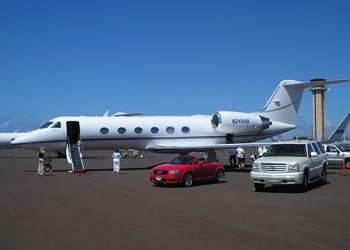 If shareholders, corporate watchdogs and consumer groups would like to know just how weak the oversight of corporate management is in America, they need to check out the abuse of corporate jets.
If shareholders, corporate watchdogs and consumer groups would like to know just how weak the oversight of corporate management is in America, they need to check out the abuse of corporate jets.
The private jet industry has more than doubled its sales in the past five years, and corporate executives form the backbone of its clientele. In addition to legitimate business trips, many executives and their families have access to the company jet for personal use, an expense picked up by their companies’ other stakeholders, including shareholders and employees. And the rest of us pay a price in diminished air quality as a result of these heavily polluting jets.
Private-jet owners probably have noticed that wholesale fuel prices have increased 418 percent over the last five years, adding $5,000 to a Gulfstream jet flight between New York and Los Angeles. But this is small potatoes for a high-flier who shelled out 10,000 times that amount or more to buy the plane in the first place. At a time when both major-party presidential candidates are vowing to give shareholders greater influence over executive compensation, the private-jet perk deserves special attention.
Stakeholders now can get a better look at jet usage among corporate titans, because new rules require the disclosure of all perks valued at more than $10,000. Personal use of corporate jets was the most common perk among 386 of the largest companies on Standard & Poors 500. A Corporate Library study found that more than half of the 215 companies surveyed allowed or required executives to use company aircraft on personal trips, with a median cost to shareholders of $182,929.
The companies with the highest fliers include Abercrombie & Fitch, which gave CEO Michael Jeffries $1.4 million worth of corporate jet time over the past two years, and Starwood Hotels, which spent $866,178 in 2006 flying CEO Steven Heyer back and forth between his Atlanta home and corporate headquarters in New York.
Sometimes it’s the CEO’s relatives who benefit. Tyson Foods chairman John Tyson is allotted 120 hours per year of corporate jet time, which he can parcel out to friends and family whether or not he accompanies them on the trip. In 2007, Qwest Communications ponied up several hundred thousand dollars so that new CEO Edward Mueller’s wife and stepdaughter could use the corporate jet to commute between Qwest’s Denver headquarters and a home in California.
It’s the norm these days for the largest firms to require CEOs to use private jets for all travel, including personal vacations, citing concerns for their executives’ security. New York University School of Business professor David Yermack says that this arrangement “is like telling the CEO: ‘We insist that you eat at a five-star restaurant for your own nutrition, and we insist that you drink $800 champagne for your health.'”
When corporate boards are approving such outrageous perks, you have to wonder what else they might be signing off on. Indeed, in virtually every recent case of corporate corruption, private jets have played a role. Countrywide Financial’s Angelo Mozilo, under investigation for his role in the subprime mortgage meltdown, threatened to resign in 2007 unless the company let his wife fly with him and cover his personal taxes for the perk.
The private-jet perk is – literally and figuratively – a high-profile sign of an executive reward system out of control. It’s time for corporate stakeholders, including institutional investors, to intervene to help CEOs break the habit.